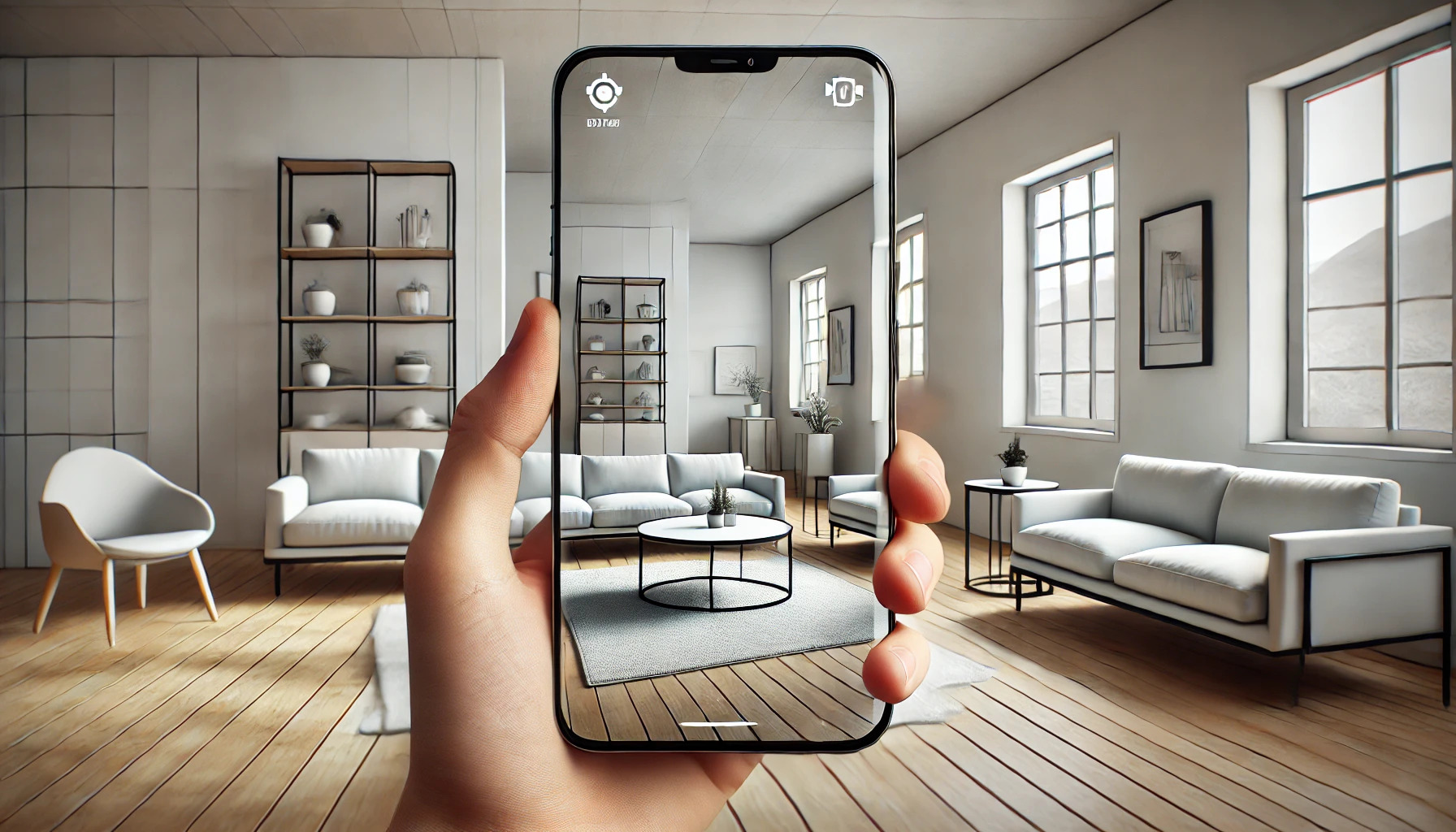In today’s world, emerging technologies are continuously making a significant impact across various fields, and digital marketing is no exception. One of these transformative technologies is Augmented Reality (AR), which is rapidly reshaping customer experiences and the way brands interact with them. In this article, produced by the Research and Development unit of Flexinexa, we explore the role of AR in digital marketing and its effects on customer engagement and brand awareness. The use of interactive technologies and innovative AR-based marketing campaigns allows brands to offer captivating and realistic experiences to their audiences, actively engaging customers through AR-driven advertising.

What is Augmented Reality (AR)?
Augmented Reality (AR) is an advanced technology that combines the real world with digital elements to create an interactive and immersive experience for users. In AR, digital information such as images, sounds, animations, or other data is layered onto the user’s real-world environment. This technology utilizes the cameras of smartphones, tablets, or specialized devices like AR glasses to detect the surroundings and superimpose digital content onto it.
Unlike Virtual Reality (VR), which completely immerses the user in a fully virtual environment, AR keeps the user in the real world while allowing them to interact with both real and virtual elements simultaneously. This feature has made AR an effective tool across various fields, including digital marketing, education, video games, and even the medical industry.
In digital marketing, AR enables brands to create unique and engaging experiences for their customers. Users can virtually try out products, interact with brands in new and creative ways, thereby enhancing customer engagement and brand awareness. AR’s ability to provide a more personalized and realistic experience plays a significant role in capturing attention and increasing customer interaction with brands.
A prominent example of Augmented Reality (AR) usage in the real world is the IKEA Place app launched by IKEA. This app allows customers to use their smartphones to virtually place IKEA furniture and home decor items in their own living spaces and see how they would look in real life.
Users can view the size, color, and arrangement of the furniture and decide if the product fits their home before making a purchase. This greatly enhances the online shopping experience, giving customers the ability to interactively explore and compare products without needing to physically visit the store.
This use of AR helped IKEA personalize the shopping experience, increase customer engagement, and build confidence in their purchasing decisions.

The role of Augmented Reality (AR) in digital marketing
The role of Augmented Reality (AR) in digital marketing is incredibly exciting and transformative, offering a new and innovative way for customers to engage with brands. Unlike traditional advertising, where customers passively view images or videos, AR allows them to directly experience products. Here’s a detailed explanation of AR’s role in digital marketing:
Personalized and Unique Experience for Customers
In traditional marketing, customers can only imagine how a product looks or feels by viewing images or videos. However, with AR, customers can virtually try the product in their own environment. For example, the home furnishing brand IKEA allows users to place virtual furniture in their homes through its AR app, giving them a realistic view of how the product will fit in their space. This personalized experience makes the shopping decision more confident and satisfying.
Active and Engaging Customer Interaction
One limitation of traditional advertising is that it requires passive observation from customers. AR changes this by making interactions active. For instance, the beauty brand Sephora uses AR to let customers virtually try different makeup shades on their faces before purchasing. This direct interaction with the product keeps customers engaged longer and more deeply with the brand.
Increased Customer Trust and Reduced Return Rates
One major concern of online shoppers is the uncertainty of how a product will look or fit in real life. AR solves this problem by allowing customers to see products in their own real-world environment before making a purchase. This reduces the risk of dissatisfaction and thus lowers return rates since customers know exactly what they’re buying.
Creating Creative and Distinct Campaigns
Brands that use AR can design creative and unique marketing campaigns that easily grab attention. For example, the car company Porsche has used AR to create virtual experiences in its advertising campaigns. Customers can view and explore Porsche cars in 3D through their phones, even checking out different features. This type of advertising stands out among competitors and creates an unforgettable experience for the customer.
Boosting Brand Awareness
AR helps brands stay top-of-mind by offering a more engaging and innovative experience. When customers interact with products in a fun, creative way, they are more likely to remember the brand. AR provides brands with the opportunity to create experiences that stick, increasing overall brand awareness.
Smarter and More Advanced Marketing
AR gives brands access to valuable data about customer behavior. For example, brands can track which products customers interact with the most through AR and use this data to improve their marketing strategies. This insight enables brands to perform smarter marketing and continuously enhance the customer experience.
Augmented Reality (AR) plays a significant role in transforming and enhancing digital marketing. By offering personalized experiences, boosting customer engagement, building trust, and creating creative campaigns, AR enables brands to not only attract more customers but also build deeper and longer-lasting relationships with them. This technology is paving the way for the future of digital marketing and is a powerful tool for driving innovation in customer experiences.

Advantages of Using AR in Digital Marketing:
Increased Customer Engagement: AR provides interactive and engaging experiences, increasing customer involvement with the brand.
Personalized Shopping Experience: Customers can virtually try products and customize their shopping experience.
Enhanced Brand Awareness: Creative AR campaigns make brands more memorable to customers.
Reduced Purchase Risk: Customers can see how products fit into their environment, leading to better purchasing decisions and fewer returns.
Market Differentiation: AR helps brands offer unique and creative advertisements that stand out and easily capture attention.
Disadvantages of Using AR in Digital Marketing:
High Costs: Developing and implementing AR technology can be expensive, especially for smaller brands.
Requires Special Equipment: Customers may need smartphones with advanced cameras or AR glasses for a better experience.
Technical Limitations: Issues with environment detection and software performance can impact user experience.
Customer Awareness: Many customers are still unfamiliar with AR, and using it may require education or guidance.
Limited Accessibility: Not all users have access to high-speed internet or AR-compatible devices, limiting the reach of AR campaigns.

Augmented Reality (AR) is one of the most innovative and powerful tools in today’s digital marketing landscape. By creating interactive, personalized, and immersive experiences, AR significantly enhances customer engagement with brands. It allows customers to visualize products in their real-world environments, leading to more confident purchase decisions and increased customer satisfaction, while reducing return rates.
However, there are challenges to adopting AR, including high development costs, the need for advanced equipment, and the fact that many customers are still unfamiliar with the technology. Additionally, limited access to high-speed internet and AR-compatible devices may restrict the reach of AR campaigns in certain markets.
Despite these obstacles, brands that effectively implement AR can create creative and unique marketing campaigns that remain memorable and engage customers in more active ways. AR provides brands with the ability to offer experiences that go beyond traditional advertising—experiences that are both interactive and personalized. Therefore, despite the challenges, AR is a valuable tool for brands seeking to differentiate themselves in a competitive market and build deeper connections with their customers.
_________________________________________________
FAQ
- What is Augmented Reality (AR) and how does it work in digital marketing?
Answer: Augmented Reality (AR) is a technology that overlays digital content onto the real world, creating an immersive experience for users. In digital marketing, AR is used to enhance customer engagement by allowing them to interact with virtual elements, such as trying on products, visualizing furniture in their home, or exploring 3D product models in real time. This leads to more interactive and personalized experiences for customers.
- How can AR marketing improve customer engagement?
Answer: AR marketing allows customers to actively engage with a brand by providing interactive experiences. For example, through AR advertising, customers can try products virtually or participate in immersive campaigns. This direct interaction creates a more memorable experience, leading to higher customer engagement and stronger brand loyalty.
- How do AR campaigns help increase brand awareness?
Answer: AR campaigns offer innovative and interactive experiences that make a lasting impression on customers. By allowing users to interact with virtual elements and experience the brand in a personalized way, AR helps brands stand out in a competitive market, increasing brand awareness and customer recall.
- What industries benefit the most from AR advertising?
Answer: AR advertising is particularly effective in industries like retail, real estate, automotive, and fashion. Brands in these sectors can use AR to create virtual product try-ons, virtual tours, or interactive product demonstrations. The immersive technology allows customers to visualize products or services in a way that traditional ads cannot offer.
- How does AR create more immersive customer experiences?
Answer: AR integrates digital elements into the physical world, enabling users to interact with products and services in a way that feels natural and real. This immersive technology enhances customer experiences by making them more engaging, interactive, and memorable, leading to higher satisfaction and increased conversion rates.
- Can small businesses afford to implement AR in their digital marketing strategies?
Answer: Yes, with the advancements in AR technology, there are affordable tools and platforms that small businesses can use to integrate AR into their marketing strategies. AR marketing offers a high return on investment by providing unique customer experiences that increase engagement, boost brand awareness, and drive sales.
- How can AR technology improve digital marketing innovation?
Answer: AR introduces new possibilities for creativity and innovation in digital marketing. From personalized AR advertising to immersive product experiences, AR technology allows brands to push the boundaries of traditional marketing methods. This innovation helps brands stay ahead of the competition and deliver cutting-edge experiences that resonate with customers.
- What role does AR play in improving customer trust and decision-making?
Answer: AR allows customers to try out products virtually, reducing uncertainty and increasing confidence in their purchase decisions. Whether it’s trying on clothes, placing furniture in their home, or visualizing a car in their driveway, AR gives customers a more accurate representation of the product, leading to better decision-making and increased trust in the brand.
- What are some successful examples of AR campaigns in digital marketing?
Answer: Some successful examples of AR campaigns include IKEA’s “Place” app, where customers can visualize furniture in their home, and Sephora’s virtual makeup try-on feature. These AR campaigns not only provided interactive experiences but also increased customer engagement and drove sales through innovative marketing strategies.
- How does AR technology enhance brand storytelling?
Answer: AR enables brands to tell their stories in more interactive and immersive ways. By blending the real world with digital content, AR allows customers to engage with a brand’s narrative on a deeper level. This makes storytelling more dynamic, capturing the customer’s attention and leaving a lasting impression that builds brand loyalty.















